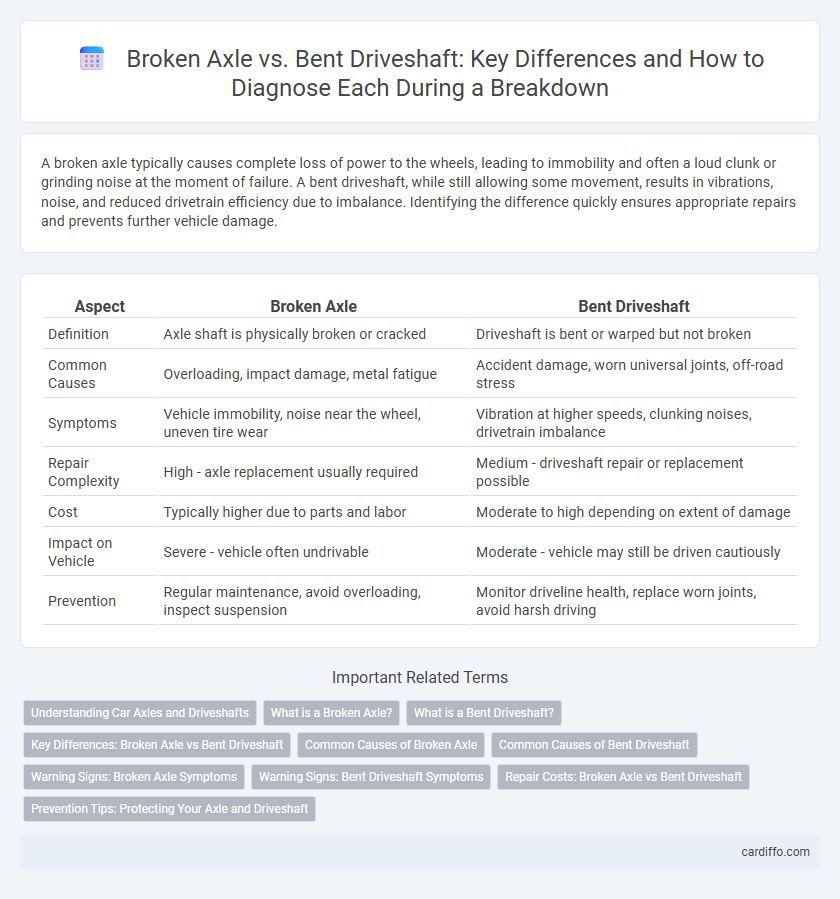A broken axle typically causes complete loss of power to the wheels, leading to immobility and often a loud clunk or grinding noise at the moment of failure. A bent driveshaft, while still allowing some movement, results in vibrations, noise, and reduced drivetrain efficiency due to imbalance. Identifying the difference quickly ensures appropriate repairs and prevents further vehicle damage.
Table of Comparison
| Aspect | Broken Axle | Bent Driveshaft |
|---|---|---|
| Definition | Axle shaft is physically broken or cracked | Driveshaft is bent or warped but not broken |
| Common Causes | Overloading, impact damage, metal fatigue | Accident damage, worn universal joints, off-road stress |
| Symptoms | Vehicle immobility, noise near the wheel, uneven tire wear | Vibration at higher speeds, clunking noises, drivetrain imbalance |
| Repair Complexity | High - axle replacement usually required | Medium - driveshaft repair or replacement possible |
| Cost | Typically higher due to parts and labor | Moderate to high depending on extent of damage |
| Impact on Vehicle | Severe - vehicle often undrivable | Moderate - vehicle may still be driven cautiously |
| Prevention | Regular maintenance, avoid overloading, inspect suspension | Monitor driveline health, replace worn joints, avoid harsh driving |
Understanding Car Axles and Driveshafts
A broken axle causes a complete loss of power transfer from the engine to the wheels, often leading to vehicle immobilization, while a bent driveshaft results in vibrations and drivetrain noise but may still allow limited movement. Car axles are crucial components that connect the wheels to the transmission, transmitting torque necessary for motion. Driveshafts, in contrast, link the transmission to the axle, enabling power transfer between these components while allowing for suspension movement.
What is a Broken Axle?
A broken axle is a critical mechanical failure where the axle shaft, responsible for transmitting power from the vehicle's differential to the wheels, snaps or fractures. This break disrupts the transfer of torque, leading to loss of vehicle mobility and potential damage to surrounding components. Unlike a bent driveshaft, a broken axle typically results in immediate and severe drivability issues requiring urgent repair or replacement.
What is a Bent Driveshaft?
A bent driveshaft is a mechanical component in a vehicle's drivetrain that has become warped or misshapen, causing vibrations and reduced performance. Unlike a broken axle, which typically results in a complete loss of power transmission to the wheels, a bent driveshaft still transmits torque but with inefficiency and potential damage to surrounding parts. Diagnosing a bent driveshaft involves checking for unusual vibrations, clunking noises, and imbalanced rotation during vehicle operation.
Key Differences: Broken Axle vs Bent Driveshaft
A broken axle typically results in complete loss of power to the wheels and severe vehicle immobilization, while a bent driveshaft causes vibrations and reduced power transfer but may still allow limited movement. Axle damage usually involves a visible crack or fracture on the axle shaft, whereas a bent driveshaft is characterized by warping or twisting without a structural break. Repairing a broken axle often requires axle replacement, whereas a bent driveshaft can sometimes be repaired by straightening or replacing the driveshaft.
Common Causes of Broken Axle
Common causes of a broken axle include severe impacts from potholes, accidents, or off-road driving, which exert excessive force beyond the axle's strength limits. Rust and corrosion weaken the axle over time, making it more susceptible to fractures under normal driving conditions. Manufacturing defects or improper installation can also contribute to premature axle failure, necessitating timely inspection and maintenance.
Common Causes of Bent Driveshaft
Common causes of a bent driveshaft include hitting road debris or potholes at high speeds, which creates significant impact force on the shaft. Off-road driving on uneven terrain and aggressive acceleration or sudden stops can also stress the driveshaft beyond its limits. Excessive vibrations from worn or unbalanced components often contribute to the driveshaft bending over time.
Warning Signs: Broken Axle Symptoms
Warning signs of a broken axle include loud clicking noises during turns, difficulty steering, and vibrations felt throughout the vehicle. A broken axle often causes the car to pull to one side and may result in complete loss of power to the wheels. Immediate inspection is crucial to prevent further damage to the drivetrain and ensure safe operation.
Warning Signs: Bent Driveshaft Symptoms
A bent driveshaft often causes vibrations felt throughout the vehicle, especially during acceleration or at higher speeds. Drivers may also notice unusual clunking noises or difficulty maintaining smooth power delivery to the wheels. Early detection of these symptoms is crucial to prevent further drivetrain damage and costly repairs.
Repair Costs: Broken Axle vs Bent Driveshaft
Repair costs for a broken axle typically range between $300 and $1,000, depending on the vehicle make and model, with replacement parts and labor being significant factors. Bent driveshaft repairs or replacements are generally more expensive, averaging from $500 to $1,200, as driveshaft components are often more complex and require precise alignment. Both repairs involve labor-intensive processes, but driveshaft issues may incur higher diagnostic and balancing fees, affecting the overall cost.
Prevention Tips: Protecting Your Axle and Driveshaft
Regularly inspect your vehicle's suspension and drivetrain components for signs of wear or damage to prevent broken axles and bent driveshafts. Maintain proper tire alignment and balance to reduce stress on the axle and driveshaft, enhancing their durability and performance. Avoid aggressive driving behaviors such as sudden acceleration or harsh off-road maneuvers, which can significantly increase the risk of failure in these critical components.
Broken axle vs bent driveshaft Infographic

 cardiffo.com
cardiffo.com